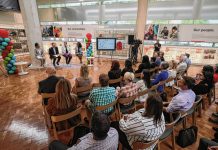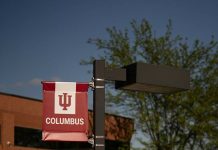An old Columbus design staple is getting an update — and a new role in promoting four key areas of the community by the end of April.
Graphic designer Paul Rand’s whimsical dancing letter C’s popped onto the scene in 1974 to represent the city.
Since a 2007 branding redesign, the old-but-new-again letter partially adorns everything from bike racks to the Columbus Area Visitors Center’s building sign. The logo originally sprang from Rand’s design of Cummins Inc. annual reports.
Now, with the scheduled April 25 official unveiling of a third-generation version of the original Rand design, a visitors center effort called the Destination Neighborhoods Project will give four sections of the local area their own visual identity, featuring icons representing:
[sc:text-divider text-divider-title=”Story continues below gallery” ]
The downtown arts district
State Street’s industrial arts corridor
AirPark Columbus Exploration District
The Taylorsville area’s Exit 76 shopping district.
And those graphics representing those four neighborhoods, as organizers are calling them although they actually are business districts, eventually will adorn ColumBUS buses and bus stops. Initially, however, the first 28 banners will decorate only the downtown area, according to the visitors center.
Designers Rick Valicenti and Bud Rodecker of the Chicago-based Thirst led the research and design process in collaboration with Greater Good Studio, a small design firm also in Chicago.
The total budget was $170,575, according to the visitors center.
The visitors center received a Tourism Development Grant from the state for half the funds. The other half came from various places: the visitors center; The Heritage Fund — The Community Foundation of Bartholomew County; the downtown cultural district; and the city of Columbus.
The project began about a year ago, according to Thirst’s leaders, who said they were delighted to freshen Rand’s work.
“What came out in our (research) with the community in those early sessions and surveys was that there still was a lot of love in the community for that heritage (the C’s) — even though many people didn’t exactly know who did it,” Rodecker said. “People said they loved it.”
Research included face-to-face verbal conversations around visitors center tables with various residents and groups. It also included phone surveys and online reactions via a software program, Valicenti said.
Yet, Rodecker added that there was a consensus “that we needed to breathe new life” into the design. Colors for the designs came from Rand’s color palette for the C’s, Thirst leaders said. They acknowledged that some of the colors for some banners seem a natural fit.
For instance, using blue on some of the banners for the AirPark seems a natural to represent the sky.
Also, some of the icons for the patterns seem a natural fit, they said. Small gear-like figures for the State Street Industrial Arts Corridor are one example.
“We respect the intelligence (for symbolism) that people have — especially around these principal (design) elements,” Valicenti said.
The banners also will feature the word “welcome” in 14 languages, from French and Hindi to Portugese and German, said Robin Hilber, the city’s community development programs coordinator who acted as a representative of local government on the effort. Cummins Inc. representatives worked with project leaders to determine the languages used as a nod to the community’s far-ranging diversity.
Karen Niverson, executive director of the visitors center, explained the project’s approach.
“They (Thirst designers) determined that a coordinated approach to branding and developing the various (neighborhood) districts would provide a more cohesive result throughout the area and provide a timeless backdrop for the iconic architectural landmarks,” Niverson said.
In the next two years, there’s a possibility the designs also could adorn area signs, and graphics-oriented sculptures similar to the vertical, Exhibit Columbus logo that adorns the parking lot of Hotel Indigo.
Not everyone is on board with the updated Rand designs just yet, however.
Columbus resident Ricky Berkey, an ardent and public supporter of Columbus’ art and architecture for years, weighed in recently.
“Personally I’m not a fan of this, but I do understand the current trends in graphic design,” Berkey said. “I don’t feel this is in any way an improvement over the original Paul Rand concepts, but I do support the process (used).”
Leaders of Exhibit Columbus, an exploration of art, architecture and design, were the first to give Valicenti a local commission — creating the logo for the exhibition portion of the event in 2016.
Richard McCoy, one of the leaders of that initiative, said he could not be more excited about Thirst’s latest work.
“This is amazing,” McCoy said. “I see this, in a certain sort of way, as a kind of extension of Exhibit Columbus.
“Part of what we are trying to do with Exhibit Columbus is to show that the past matters — and that there’s value in that. And Thirst has created a design in which they went back and made sure they understood the past, and then made it new. That’s exactly what we’re trying to do with Exhibit Columbus.
“So this shows, in a sense, the power of suggestion, in a way. It shows that there is now something in the air. To use a German term, it’s zeitgeist.”
An online graphics section called Brand New, a division of the website UnderConsideration.com, offers opinions on corporate and brand identity work. It recently posted a review of Thirst’s dancing C’s branding project in Columbus.
It included the perspective that the local effort “is some pretty fantastic and distinctive work that builds an idiosyncratic and locally relevant design language that will add to the charm of the city.”
[sc:pullout-title pullout-title=”The four “neighborhoods” of the community” ][sc:pullout-text-begin]
The Destination Neighborhoods Project branding and promotional initiative highlights four areas of the community:
- Downtown Columbus Arts and Entertainment District
- State Street Columbus Industrial Arts Corridor
- Airpark Columbus: Exploration District
- Exit 76 Columbus: The Shopping District
[sc:pullout-text-end]




